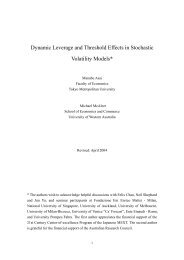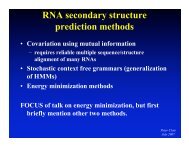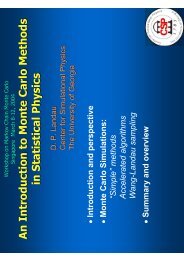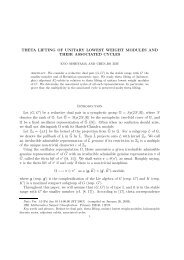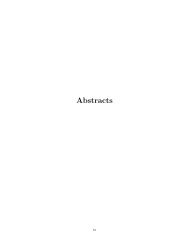Stein's method, Malliavin calculus and infinite-dimensional Gaussian
Stein's method, Malliavin calculus and infinite-dimensional Gaussian
Stein's method, Malliavin calculus and infinite-dimensional Gaussian
You also want an ePaper? Increase the reach of your titles
YUMPU automatically turns print PDFs into web optimized ePapers that Google loves.
Maxima. Suppose that X (h i ), i = 1; :::; m <strong>and</strong> h i 2 H, is a …nite subset of some isonormal<br />
<strong>Gaussian</strong> process, such that the span of h i has dimension m. Consider<br />
F =<br />
max X (h i) :<br />
i=1;:::;m<br />
Then, F 2 D 1;2 (indeed, (z 1 ; :::; z m ) 7! max z i is Lipschitz), the r<strong>and</strong>om variable<br />
I 0 = arg max X (h i)<br />
i=1;:::;m<br />
is well de…ned, <strong>and</strong> one has that<br />
DF = h I0 .<br />
This kind of results can also be extended to continuous-time <strong>Gaussian</strong> processes. For<br />
isntance, if W = fW t : t 2 [0; 1]g is a st<strong>and</strong>ard Brownian motion initialized at zero, then<br />
M = sup t2[0;1] W t 2 D 1;2 , <strong>and</strong><br />
D t M = 1 [0;T ] (t) ,<br />
where T is the unique r<strong>and</strong>om point where W attains its maximum.<br />
7.2 Divergences<br />
7.2.1 De…nition <strong>and</strong> characterization of the domain<br />
Let X = fX (h) : h 2 Hg be an isonormal <strong>Gaussian</strong> process over some real separable Hilbert<br />
space H. We will now study the divergence operator , which is de…ned as the adjoint of the<br />
derivative D. Recall that D is a closed <strong>and</strong> unbounded operator from D 1;2 L 2 ( (X)) into<br />
L 2 ( (X) ; H), so that the domain of the operator will be some suitable subset of L 2 ( (X) ; H).<br />
De…nition 7.3 The domain of the divergence operator , denoted by dom (), is the collection<br />
of all r<strong>and</strong>om elements u 2 L 2 ( (X) ; H) such that, for every F 2 D 1;2 ,<br />
<br />
E hu; DF i H<br />
cE F 2 1=2<br />
, (7.14)<br />
where c is a constant depending on u (<strong>and</strong> not on F ). For every u 2 dom (), the r<strong>and</strong>om<br />
variable (u) is therefore de…ned as the unique element of L 2 ( (X)) verifying<br />
E hu; DF i H<br />
<br />
= E [F (u)] ; (7.15)<br />
for every F 2 D 1;2 (note that the existence of (u) is ensured by (7.14) <strong>and</strong> by the Riesz<br />
Representation Theorem). Relation (7.15) is called an integration by parts formula.<br />
Remark. By selecting F = 1 in (7.15), one deduces that E [ (u)] = 0, for every u 2 dom ().<br />
Example. Fix h 2 H. Since, by Cauchy-Schwarz, E <br />
hh; DF i H<br />
khk H<br />
E F 2 1=2 , we<br />
deduce that h 2 dom () <strong>and</strong> also, thanks to (7.6), that (h) = X (h).<br />
29








